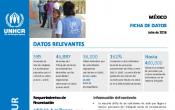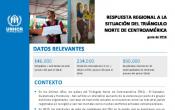Mexico
Operation: Mexico
Location
{"longitude":-103,"latitude":25,"zoom_level":5}
Latest update of camps and office locations 13 Jan 2016. By clicking on the icons on the map, additional information is displayed.
Key Figures
| 2015 end-year results | |
| 929 | individuals (449 of whom were children) were granted refugee status. Some 152 (13 of whom were children) received complementary protection services |
| 176 | visits to 15 different migration detention facilities were organized by UNHCR to intensify the delivery of information on asylum and reinforce efforts to prevent refoulement |
| 32 | shelters providing basic assistance to migrants and asylum-seekers intensified their engagement with UNHCR |
Latest Updates and Related Links
People of Concern
9%
Decrease in
2015
2015
| 2015 | 4,286 |
| 2014 | 4,722 |
| 2013 | 3,196 |

[["Refugees",2923],["Asylum-seekers",1350],["Stateless",13]]
Loading ...
Budgets and Expenditure for Mexico
< Back
2015
{"categories":[2012,2013,2014,2015,2016],"budget":[2.99001113,3.09862171,2.99046312,4.08857563,12.42904304],"expenditure":[1.62867512,2.21493065,1.99483238,2.62872464,null]}
{"categories":[2012,2013,2014,2015,2016],"p1":[2.99001113,3.09862171,2.99046312,4.08857563,12.42904304],"p2":[null,null,null,null,null],"p3":[null,null,null,null,null],"p4":[null,null,null,null,null]}
{"categories":[2012,2013,2014,2015,2016],"p1":[1.62867512,2.21493065,1.99483238,2.62872464,null],"p2":[null,null,null,null,null],"p3":[null,null,null,null,null],"p4":[null,null,null,null,null]}
Loading ...
CHOOSE A YEAR
- 2015
Working environment
- The deterioration of the situation in the Northern Triangle of Central America (NTCA) continued to steadily push thousands of people to search for international protection in Mexico.
- What was considered to be mostly a mixed migration movement is now turning into a refugee crisis, with numerous protection challenges.
- Faith-based shelters, distributed along routes used by refugees and migrants, continue to serve as the country’s main response to basic protection and humanitarian needs.
Population trends in 2015
- The Ministry of Interior’s statistics indicated that 170,323 NTCA nationals were detained in 2015, including some 18,402 unaccompanied children. A total of 3,423 individuals submitted an asylum claim to the Mexican Refugee Commission (COMAR). Approximately 40 per cent of the asylum-seekers in Mexico filed their claim in Chiapas.
- 929 individuals were granted refugee status, of whom 449 were children, and some 152 received complementary protection, of whom 13 were children.
- 361 individuals officially withdrew their asylum claim, often due to prolonged detention, and a total of 668 persons abandoned the asylum procedure, including due to lack of adequate reception arrangements.
Achievements and impact
- UNHCR’s strategy focused on ensuring those detained receive adequate information on how to access asylum. Through some 176 visits to 15 different migration detention facilities in 11 states in Mexico, the Office intensified the delivery of information on asylum, reinforcing efforts to prevent refoulement.
- UNHCR intensified engagement with some 32 shelters providing basic assistance to migrants and asylum-seekers. The conditions of some 13 shelters in southern Mexico and Mexico City were improved, benefiting LGBTI asylum-seekers, children, and families.
- Access to legal aid was enhanced, mostly due to the arrival of UNHCR’s partner, Asylum Access, in Tenosique and the Comisión Mexicana de Defensa y Promoción de Derechos Humanos, in Mexico City, as well as UNHCR’s support to two shelters’ lawyers in southern Mexico.
- Access to direct material assistance, including increased cash-based assistance, and the standardization of criteria and procedures to assist were pursued and implemented with COMAR.
Unmet needs
- The detention and expedited deportation of almost all irregular migrants intercepted by authorities continued as a challenge to the timely identification of persons with protection needs and to their referral to asylum procedures, more effectively preventing instances of refoulement.
- Asylum-seekers benefiting from legal aid remained extremely low nationwide, less than 5 per cent of the total registered population of concern to UNHCR.
Working environment
Mexico is part of a broad migration pattern in the region with as many as 400,000 people entering and transiting the country each year. High levels of criminal violence in El Salvador, Guatemala and Honduras have led to the flight of increasing numbers of people, who try to enter Mexico either to transit towards North America or to seek international protection within Mexico. Insecurity, human rights violations and persecution perpetrated mainly by non-state actors, such as gangs and criminal groups, are at the source of such displacement.Moreover, fragile law enforcement agencies and judicial systems in countries of origin are often unable to protect victims. The situation affects adolescents and children in particular.
In this complex operational environment, UNHCR’s capacity to provide the required legal and material assistance for people in need of international protection is limited financially. Moreover, given the country’s size and extensive border regions, additional UNHCR field presence is required to reach out to regions where an increasing number of people of concern are arriving.
The protection environment in Mexico is positive, with strong international laws and active collaboration between the authorities and UNHCR. Unfortunately, access to the Refugee Status Determination (RSD) procedure remains limited in the absence of sufficient systematic screening tools to detect people with protection risks.
Migrants and asylum-seekers who enter Mexico irregularly are automatically detained in migration detention facilities administered by the authorities. Detention, and the absence of viable alternatives, remain a deterrent to seeking asylum in Mexico. Consequently, this has rendered the international protection needs of people fleeing criminal violence and persecution in Central America almost invisible. In light of this, Mexico has been selected as a pilot country for the implementation of UNHCR’s global detention strategy for the period 2014-2018.
While refugees have access to basic public services, their access to the formal labour market remains limited. In 2014, the Government of Mexico City extended its unemployment insurance scheme to all refugees living in Mexico City, and the Mexican Commission for Refugees (COMAR) has initiated several actions aimed at expanding refugees’ access to formal job opportunities at the national level.
Needs and strategies
UNHCR’s strategy in Mexico for 2015 will focus on strengthening the asylum system by increasing the country’s observance of due process guarantees and expanding protection space. Efforts will focus on improving access to the RSD system and supporting projects to ensure a fair and effective process.Additionally, the increasing number of asylum claims from Central Americans fleeing criminal violence and persecution has led the Office to pursue a multi-year protection strategy. This includes a child-protection strategy for strengthening protection and care according to the best-interest principle; a strategy to enhance the prevention of and response to sexual and gender-based violence (SGBV) against people of concern; a national detention action plan, aiming to support the Government to end the detention of asylum-seekers and refugee children, while creating viable alternatives to detention and improving detention conditions.
Local integration remains the preferred and most reachable durable solution for refugees, with few opting for repatriation. The Office will therefore pursue the elaboration and implementation of a comprehensive local integration strategy, focused on urban locations.
Related to the alarming increase in the numbers of UASC, UNHCR will support identification and referral mechanisms that allow migration authorities to identify, assess and refer individuals in need of international protection to the appropriate response and protection mechanisms.






